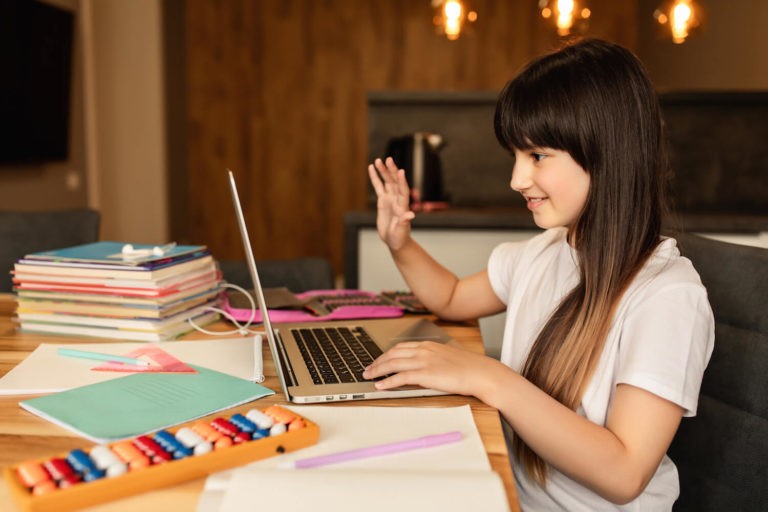It wouldn’t surprise you to hear that the learning process is at its peak when connection is involved. We retain and commit information to memory when there are emotional factors involved in our learning, which are created by interaction with others in the learning process.
So, what does that mean for students who are at their kitchen table accessing all of their learning from a device this year? There are still many ways to create that connection remotely to optimize learning for your students, but it requires learning a few new tricks and taking some academic risks to try new things.
The Benefits of a Collaborative Classroom
A collaborative learning environment provides myriad benefits to our students. First and foremost, it creates the opportunity to practice social and emotional well-being skills, including turn-taking, respectful discourse, and appreciation for diversity and diverse thinking.
Further, a collaborative environment promotes high-level instructional pedagogy skills like productive struggle in a collaborative group and posing meaningful questions. While it is certainly attainable to engage in this type of thinking in a one-on-one setting with an adult tutor and student, it is infinitely more powerful for students to learn these skills and engage in these experiences with peers, teaching authentic use of these work habits.
Likely the most important benefit is of course the social connection it provides. Families who have opted for remote learning, or communities that are forced into remote learning, express that one of the biggest challenges is not being able to provide social opportunities to children while stuck at home.
Social connection is critical to child development, moving students away from an egocentric view of the world, developing emotional connections and fulfillment, and of course creating opportunities to learn about social interaction through real-life experiences and peer feedback. As a remote teacher, you are a critical link in ensuring students don’t miss out on this vital element to their personal growth, so focusing on creating a collaborative environment is a critical component to your instructional responsibilities!
Strategies for Fostering a Collaborative Classroom Virtually
Start with Community Connection
At the onset of your remote instruction, creating time for students to discuss and contribute to a list of expectations for how they want to be treated and treat one another establishes the understanding that community and collaboration are important, even if online.
You may consider making a classroom charter, but instead of construction paper, trying an online tool like Padlet or just making a shared Google Doc that can be revisited. Then, continue to make time to revisit norms and community beliefs by starting each remote learning session with a greeting and/or moment of reflection to remind others of interpersonal expectations and their importance online.
Facilitate Meaningful Discourse
Opportunities for discourse and discussion are more available than we may have originally thought when embarking on remote learning early in 2020. Whether it is teaching students how to collaborate on a Google Doc through the comments feature, utilizing a breakout room feature, or turning the “teaching” over to the student to walk the group through a challenging problem or concept are all strategies that require students to communicate with one another respectfully.
Of course, before letting students go off electronically communicating, explicit instruction on how to do so productively is required. Reviewing sample comments to identify what is respectful or disrespectful, assigning roles within a collaborative group to maintain time and order, and including self-reflections on discourse skills used in breakouts are all instructional moves that help students engage productively with one another online.
Make Time for Fun
The piece that gets lost the most in remote learning is the natural opportunity to see a student’s personality in an authentic way beyond the learning task. Carving out time to play games or share about personal topics contributes significantly to a productive collaborative environment.
Start with some more structured activities like a Google Slides trivia game (think pop culture questions or class-based questions like “whose mask is this” with pictures of each member’s mask) where students can guess in the chat box. Over time, you can fold in more open shares or activities once trust and norms have been established.
Make it a Goal
Like a regular classroom, having behavioral learning targets alongside content-based learning targets is important, since school is for learning about behaviors, too! Having a behavioral goal for students related to participation, asking questions, giving feedback to peers, or active listening keeps the importance of a collaborative environment at the center of your instruction. Having students work towards and reflect on success with these collaborative behaviors will help foster connection and cooperation despite being remote.
Celebrate!
Create routines of celebration within your instruction and especially your closure so that students develop the habit of recognizing and celebrating one another’s achievements and efforts. It could look like sharing gratitude for one another, sharing “put-ups” (opposite of “put-downs”), doing a class cheer for someone’s achievement, or using an e-platform like Padlet or Flipgrid to create compliment boards for each other. Making these celebrations a part of the learning routine demonstrates to learners its importance and supports their emotional well-being during the challenge of learning from home.




